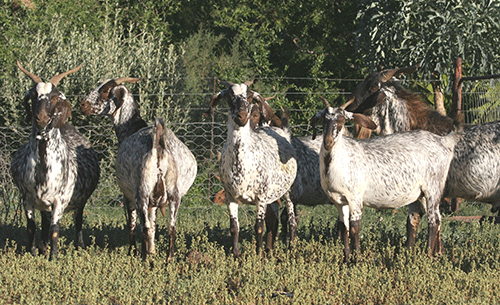Annelie Coleman
Changing weather conditions and Africa’s severe poverty demand tough, easy-to-care-for livestock. The answer, says breeder Deon Vlok, is indigenous veld goats.
Vlok, who runs indigenous veld goats on 50 000ha between Calvinia and Brandvlei in the Northern Cape, South Africa, said his animals truly showed their mettle during the recent eight-year drought, proving to be a mainstay for his farm.
He started farming indigenous goats in 1985, and breeds the four well-known ecotypes found in southern Africa: the Kaokoveld Kunene, the Mbuzi, the Cape speckled and the Eastern Cape Xhosa lob-ear.
Low input costs
According to Vlok, the goats’ incomparable maternal instincts and hardy constitution mean they can drop and raise kids without fuss, even in times of want. This, coupled with the fact that they are indiscriminate feeders, cuts down on input costs.
Their hard, well-developed brown hooves enable them to walk comfortably over virtually any terrain. Although they are outstanding browsers and will eat virtually anything, they are so well adapted to veld conditions that, while many breeders background goats for marketing purposes, Vlok’s goats can be marketed directly from the veld, cutting input costs even more.
He says this is because indigenous veld goats have been naturally selected over millennia for disease and parasite resistance and functional efficiency, including the exceptional walking ability. This enables them to traverse long distances in search of water and grazing.
Another advantage is that the animals mature early, so a small flock can be increased over a relatively short time into a profitable business.
Strong maternal traits
The goats’ outstanding fertility and kidding ease are demonstrated by the fact that Vlok’s herd maintained a kidding rate of between 120% and 130% during the drought.
The rams are left with the ewes throughout the year and kidding is thus determined by nature. Vlok firmly believes in the principle of allowing natural selection to take its course.
The respective genotypes’ birth and weaning weights differ from one other, but the weaners are marketed at about four months, weighing between 25kg and 35kg.
The goats are not vaccinated, and the flocks are kept in 800ha camps with two or three watering points each on shallow loam soils dotted with rocky outcrops.
The vegetation is mainly Karoo flora. The grazing consists largely of herbaceous shrubs and a small component of grass species, including purple veld grass (Ehrharta calycina, or rooisaadgras) and thimble grass (Fingerhuthia Africana).
During the drought, the farm’s average annual rainfall was less than 100mm.
Four ecotypes
Southern Africa’s four indigenous veld goat ecotypes have developed over centuries, and Vlok believes that they are the ideal livestock option to alleviate poverty in Africa.
According to the Indigenous Veld Goat Breeders’ Society of South Africa, the Nguni ecotype is characterised by a small, compact and well-proportioned body with strong, medium-to-long legs. The goats are multicoloured, with a dappled or speckled coat, and are horned with a concave head. Their ears are small to medium in size.
The robust Eastern Cape Xhosa lob-ear goat is large-framed and well-muscled and has strong, medium-to-long legs. It is a multicoloured animal known for its dappled marble and flowery patterns, and some may be speckled. Its profile is flat to slightly convex, bulging and rather long and strong.
This ecotype is known for its large, lobed and droopy ears, with large horns that grow upward and outward.
The Cape speckled goat is a large, well-muscled animal with a white body covered with red-brown or black spots. Its profile is convex to flat and rather long, with a slight dip in front of the eyes. Its ears are large and droopy, and its horns grow upward and outward, with the tips curving in.
The Kaokoveld Kunene ecotype is a slender, medium-framed goat. Its coat is multicoloured, two-toned, pied, speckled and/or dappled. It has a flat to slightly convex profile with a narrow face, and its horns grow slightly upward and a little outward, usually the length of its head.
Vlok says that the value of indigenous livestock breeds, in general, came to the fore during the devastating drought.
“I like to compare different breeds and found that indigenous sheep breeds such as the Damara, Persian, Van Rooy and Afrikaner, which I also farm, outperformed other breeds by far.
“I’m committed to retaining the inherent traits of these breeds, as well as those of the indigenous veld goats. The indigenous breeds developed over many, many years and don’t need to be changed,” he says.


